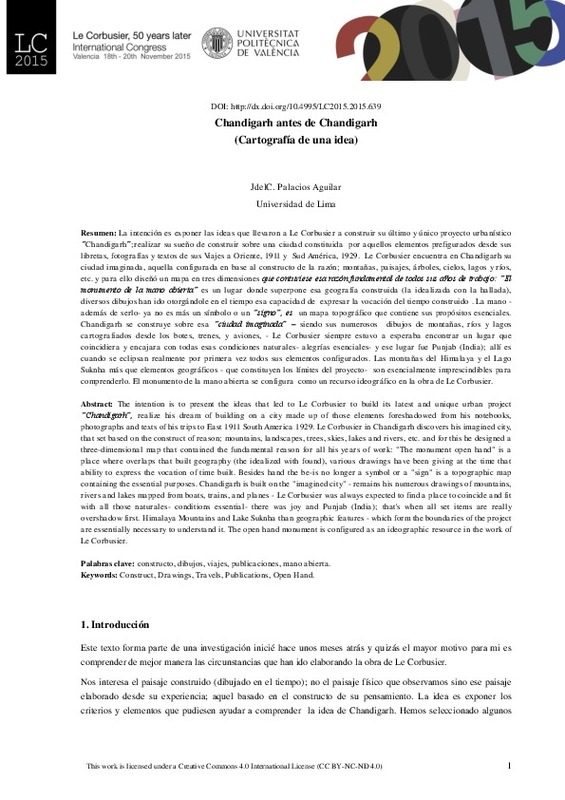JavaScript is disabled for your browser. Some features of this site may not work without it.
Buscar en RiuNet
Listar
Mi cuenta
Estadísticas
Ayuda RiuNet
Admin. UPV
Chandigarh antes de Chandigarh (Cartografía de una idea)
Mostrar el registro sencillo del ítem
Ficheros en el ítem
| dc.contributor.author | Palacios Aguilar, José del Carmen
|
es_ES |
| dc.date.accessioned | 2017-09-12T06:23:51Z | |
| dc.date.available | 2017-09-12T06:23:51Z | |
| dc.date.issued | 2016-03-03 | |
| dc.identifier.isbn | 9788490483732 | |
| dc.identifier.uri | http://hdl.handle.net/10251/87055 | |
| dc.description.abstract | [EN] The intention is to present the ideas that led to Le Corbusier to build its latest and unique urban project “Chandigarh”, realize his dream of building on a city made up of those elements foreshadowed from his notebooks, photographs and texts of his trips to East 1911 South America 1929. Le Corbusier in Chandigarh discovers his imagined city, that set based on the construct of reason; mountains, landscapes, trees, skies, lakes and rivers, etc. and for this he designed a three-dimensional map that contained the fundamental reason for all his years of work: "The monument open hand" is a place where overlaps that built geography (the idealized with found), various drawings have been giving at the time that ability to express the vocation of time built. Besides hand the be-is no longer a symbol or a "sign" is a topographic map containing the essential purposes. Chandigarh is built on the "imagined city" - remains his numerous drawings of mountains, rivers and lakes mapped from boats, trains, and planes - Le Corbusier was always expected to find a place to coincide and fit with all those naturales- conditions essential- there was joy and Punjab (India); that's when all set items are really overshadow first. Himalaya Mountains and Lake Suknha than geographic features - which form the boundaries of the project are essentially necessary to understand it. The open hand monument is configured as an ideographic resource in the work of Le Corbusier | es_ES |
| dc.description.abstract | [ES] La intención es exponer las ideas que llevaron a Le Corbusier a construir su último y único proyecto urbanístico “Chandigarh”;realizar su sueño de construir sobre una ciudad constituida por aquellos elementos prefigurados desde sus libretas, fotografías y textos de sus Viajes a Oriente, 1911 y Sud América, 1929. Le Corbusier encuentra en Chandigarh su ciudad imaginada, aquella configurada en base al constructo de la razón; montañas, paisajes, árboles, cielos, lagos y ríos, etc. y para ello diseñó un mapa en tres dimensiones que contuviese esa razón fundamental de todos sus años de trabajo: “El monumento de la mano abierta” es un lugar donde superpone esa geografía construida (la idealizada con la hallada), diversos dibujos han ido otorgándole en el tiempo esa capacidad de expresar la vocación del tiempo construido . La mano - además de serlo- ya no es más un símbolo o un “signo”, es un mapa topográfico que contiene sus propósitos esenciales. Chandigarh se construye sobre esa “ciudad imaginada” – siendo sus numerosos dibujos de montañas, ríos y lagos cartografiados desde los botes, trenes, y aviones, - Le Corbusier siempre estuvo a esperaba encontrar un lugar que coincidiera y encajara con todas esas condiciones naturales- alegrías esenciales- y ese lugar fue Punjab (India); allí es cuando se eclipsan realmente por primera vez todos sus elementos configurados. Las montañas del Himalaya y el Lago Suknha más que elementos geográficos - que constituyen los límites del proyecto- son esencialmente imprescindibles para comprenderlo. El monumento de la mano abierta se configura como un recurso ideográfico en la obra de Le Corbusier | es_ES |
| dc.format.extent | 8 | es_ES |
| dc.language | Español | es_ES |
| dc.publisher | Editorial Universitat Politècnica de València | es_ES |
| dc.relation.ispartof | LE CORBUSIER. 50 AÑOS DESPUÉS | es_ES |
| dc.rights | Reconocimiento - No comercial - Sin obra derivada (by-nc-nd) | es_ES |
| dc.subject | architecture | es_ES |
| dc.subject | le corbusier | es_ES |
| dc.subject | modern movement | es_ES |
| dc.title | Chandigarh antes de Chandigarh (Cartografía de una idea) | es_ES |
| dc.type | Capítulo de libro | es_ES |
| dc.type | Comunicación en congreso | es_ES |
| dc.identifier.doi | 10.4995/LC2015.2015.639 | |
| dc.rights.accessRights | Abierto | es_ES |
| dc.description.bibliographicCitation | Palacios Aguilar, JDC. (2016). Chandigarh antes de Chandigarh (Cartografía de una idea). En LE CORBUSIER. 50 AÑOS DESPUÉS. Editorial Universitat Politècnica de València. 1625-1642. https://doi.org/10.4995/LC2015.2015.639 | es_ES |
| dc.description.accrualMethod | OCS | es_ES |
| dc.relation.conferencename | LC2015 - Le Corbusier, 50 years later | es_ES |
| dc.relation.conferencedate | November 18-20,2015 | es_ES |
| dc.relation.conferenceplace | Valencia, Spain | es_ES |
| dc.relation.publisherversion | http://ocs.editorial.upv.es/index.php/LC2015/LC2015/paper/view/639 | es_ES |
| dc.description.upvformatpinicio | 1625 | es_ES |
| dc.description.upvformatpfin | 1642 | es_ES |
| dc.type.version | info:eu-repo/semantics/publishedVersion | es_ES |
| dc.relation.pasarela | OCS\639 | es_ES |








